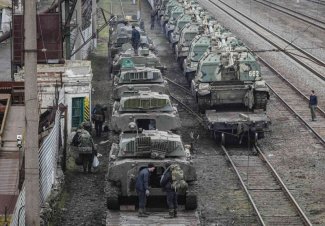Russia attacks Ukraine

On the night of 23/24 February, Russian President Vladimir Putin delivered a message to the nation, during which he announced the beginning of a special military operation aimed at defending the people of Donbas against ‘genocide’, and at achieving the “demilitarisation and de-Nazification of Ukraine”. As a basis for initiating the aggression, he referred to the request from the separatist ‘republics’ for help, and to a desire to defend the population, which “has been a victim of genocide by the Kyiv regime for eight years”. He announced that those who have committed “bloody crimes”, including against citizens of Russia, will be brought to justice.
In the morning, the Armed Forces of the Russian Federation launched an attack from the territories of Russia and Belarus on military infrastructure facilities throughout Ukrainian territory, as well as on border infrastructure facilities. These activities began with a series of precision air and missile attacks (from both land and sea), with the participation of sabotage and reconnaissance groups, on the Ukrainian defence forces’ air defence systems (radar stations and rocket launchers), its main airports (including the military and strategically important Boryspol) and military bases (mainly brigade ammunition depots). At the same time, offensive actions were launched from the occupied part of the Donbas on the Ukrainian part of Luhansk oblast (Russian troops have allegedly taken over Stanitsa Luhanska and are storming the town of Shchastia).
Around 8am Central European time, land formations of the Russian army crossed the border of Ukraine and entered Kharkiv, Sumy and Chernihiv oblasts from the north, as well as from Crimea into Kherson oblast. For the time being, however, there are no signs that they have launched an offensive any deeper into Ukrainian territory. Reports of Russian landings near Odesa and Mykolayiv turned out to be disinformation. During this period, the Russian command reported that the Ukrainian air defence had been neutralised, while the Ukrainian command said that five planes and a helicopter of the Russian army had been shot down.
Commentary
- The content of Putin’s speech shows that his immediate goal is to take control of Ukraine and form a government loyal to Russia. He sees this as an element of restoring a just order, which – according to him – was violated by the West (under the leadership of the US) at the time of the collapse of the USSR in the early 1990s. Thus, the aim of his actions is an attempt to restore this order in some unspecified form, but including the use of armed force. At the same time, he has warned the West that if it attempts to actively oppose Russia’s actions in Ukraine, Moscow will use all its potential against Western states.
- The activities which the Russian armed forces have initiated are a classic preparatory phase for joint forces (land-sea-air) operations, to be conducted with the use of the entire spectrum of available resources. Targets throughout the territory of Ukraine are being attacked by bomber and assault aviation, surface-to-surface (Iskander) and water-to-surface (Kalibr) missiles, as well as by sabotage and reconnaissance groups (which had previously been positioned in Ukraine). Regarding the targets in the border regions, these are being attacked by artillery and small arms, without coming into direct contact with Ukrainian army units (except for the operations in the Donbas). These moves are designed to cause the largest possible losses to the Ukrainian armed forces (while being insufficient to completely destroy them) and create the necessary conditions for the possible start of the land phase of the operation.
- It remains an open question how effective the Russian attacks – as well as the Ukrainian resistance – have been so far. However, it should be assumed that in most cases the targets attacked were not completely destroyed (the information available shows that the precision strikes were not on a mass scale), but they are now at least partially unusable (as a result of damage to the airport runways, and in the case of the air defence system, the elimination of radar stations). In comparison with the number of targets under attack – several dozen sites throughout Ukrainian territory – the Russian losses so far (if confirmed) should be considered as merely symbolic.
- In the coming hours, we should expect the Russian air-missile strikes against military targets to continue, with Ukrainian army columns to come under fire later (so far, apart from the air defence system, the only targets have been infrastructure). The commencement of the land phase of the operation proves that the Russian side has gained mastery of the air, at least in relative terms (i.e. directly over the area of operations). However, we should assume that the pace at which the land operations expand depends not only on the resistance of the Ukrainian army, but also on other factors.
Analysis as of 9 AM.




